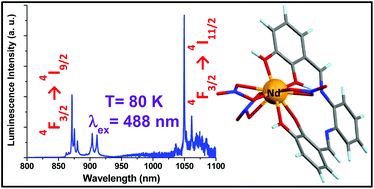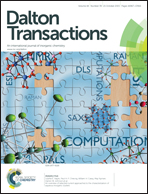Spectroscopic studies of lanthanide complexes of varying nuclearity based on a compartmentalised ligand†
Abstract
The synthesis, characterization and solid-state luminescence spectroscopy of mononuclear (f), heterodinuclear (d–f) and heterotrinuclear (d–f–d) coordination compounds with the compartmental ligand N,N′-bis(3-hydroxyl salicylidene)benzene-1,2-diamine (H2L) are reported. The trivalent lanthanide ions NdIII, SmIII, EuIII, GdIII, TbIII and DyIII as single metal centres or in combination with either ZnII or NiII were coordinated. Compounds are characterised by elemental analyses, IR, 1D and 2D solution 1H and 13C NMR spectroscopy, measurements of magnetic moments and solid state UV-Vis-NIR reflectance, luminescence and Raman spectroscopy techniques. Crystal structures of the dinuclear compounds [SmZn(O2NO)3(L)(OH2)]·EtOH and [DyZn(O2NO)2(Cl)(L)(EtOH)]·3EtOH and the trinuclear compound [TbZn2(L)2(Cl)2(OH2)](NO3)·EtOH are presented, where samarium(III) displays a coordination number of ten, with a bicapped cubic geometry, while for the dysprosium compound a nine-coordinated environment with a tricapped trigonal prismatic geometry is shown. Their crystals belong to the triclinic system and the P![[1 with combining macron]](https://www.rsc.org/images/entities/char_0031_0304.gif) space group. The coordination number for terbium(III) in the trinuclear complex is nine, with a tricapped trigonal prismatic geometry, and its crystal belongs to the monoclinic system, space group C2/c. For these three compounds, the zinc ion stabilises a penta-coordinated environment with square pyramid geometry. All mononuclear and dinuclear compounds are neutral, whereas the trinuclear complexes are ionic. The results of DFT theoretical calculations for the ligand (H2L) are used to assign the ligand singlet and triplet excited state energy levels. Luminescence studies of the neodymium compounds indicate that the ligand is a sensitizer for NIR emitters.
space group. The coordination number for terbium(III) in the trinuclear complex is nine, with a tricapped trigonal prismatic geometry, and its crystal belongs to the monoclinic system, space group C2/c. For these three compounds, the zinc ion stabilises a penta-coordinated environment with square pyramid geometry. All mononuclear and dinuclear compounds are neutral, whereas the trinuclear complexes are ionic. The results of DFT theoretical calculations for the ligand (H2L) are used to assign the ligand singlet and triplet excited state energy levels. Luminescence studies of the neodymium compounds indicate that the ligand is a sensitizer for NIR emitters.


 Please wait while we load your content...
Please wait while we load your content...